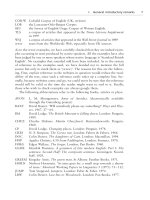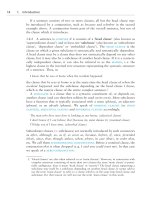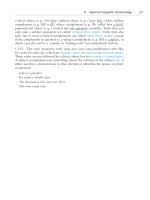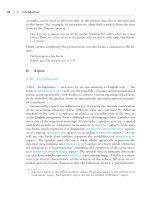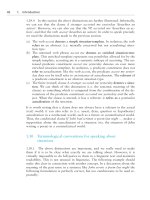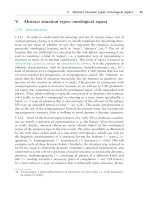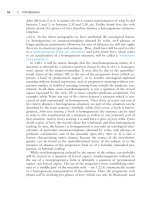The grammar of the english verb phrase part 2 doc
Bạn đang xem bản rút gọn của tài liệu. Xem và tải ngay bản đầy đủ của tài liệu tại đây (74.97 KB, 7 trang )
1. Introduction
I. General introductory remarks 4
1.1 Aims and scope of the work 4
1.2 Symbols and conventions 5
1.3 The illustrative material 6
1.4 The structure of the book 8
II. General linguistic terminology 12
1.5 ‘Situation’, ‘actualization, ‘actualize’ 12
1.6 Phrases 12
1.7 Clause, predicate 13
1.8 Sentences 13
1.9 Alternative definitions of ‘verb phrase’ 15
1.10 Tensed vs nontensed verb forms 15
1.11 ‘Present’ and ‘perfect’ nonfinite forms 17
1.12 Lexical verbs vs auxiliaries 18
1.13 Transitive vs intransitive lexical verbs 20
III. Meaning categories expressed by verb forms 22
A. Tense 22
1.14 Introduction 22
1.15 The formation of the present tense 23
1.16 The formation of the past tense 23
1.17 The formation of the other tenses 24
1.18 The meanings of tenses: expressing temporal relations 25
1.19 Special uses of tenses 27
B. Aspect 28
1.20 Introduction 28
1.21 Perfective aspect 30
1.22 Imperfective aspect 31
1.23 Habitual aspect 33
1.24 Repetitive vs semelfactive aspect 35
1.25 Aspectual form vs aspectual meaning 37
1.26 Perfect aspect? 37
C. Mood and modality 38
1.27 Definition of mood and modality 38
IV. The precise meanings and uses of ‘situation’ and ‘actualization’ 40
1.28 Definition of ‘situation’, ‘actualize’ and ‘actualization’ 40
1.29 Situation: meaning (denotation) versus reference 40
1.30 Terminological conventions for speaking about situations 42
1.31 Terminology used to refer to situation types and verb classes 45
1.32 Situation types 47
2 1. Introduction
V. Abstract situation types: ontological aspect 49
1.33 Introduction 49
1.34 Ontological feature 1: ‘static’ versus ‘dynamic’ 51
1.35 Ontological feature 2: ‘agentive’ versus ‘nonagentive’ 53
1.36 Ontological feature 3: ‘homogeneous’ versus ‘heterogeneous’ 55
1.37 Ontological feature 4: ‘durative’ vs ‘punctual’ 57
1.38 Ontological feature 5: [( transitional] 59
1.39 Ontological feature 6: ‘telic’ vs ‘atelic’ 60
1.40 Ontological feature 7: [( evolving] 65
VI. Classifications of situation types 66
1.41 Introduction 66
1.42 Classification 1: states, actions, events and processes 66
1.43 Classification 2: Vendler’s taxonomy 70
VII. Actualization aspect: ‘bounded’
vs
‘nonbounded’ 72
1.44 Definition of (non)bounded situations/clauses 72
1.45 ‘Nonbounded actualization’ ϭ ‘homogeneous actualization’ 74
1.46 (Non)boundedness and duration adverbials 75
1.47 (Non)boundedness vs (a)telicity 77
1.48 (Un)bounding clause constituents 79
VIII. The aspectual interpretation of a clause 81
1.49 Aspectual interpretation 81
IX. Summary of chapter 1 83
1.50 Parts I and II 83
1.51 Part III 83
1.52 Part IV 84
1.53 Part V 85
1.54 Part VI 87
1.55 Part VII 88
1.56 Part VIII 88
Abstract 3
Abstract
The aim of this book is to describe the workings
of the system of special verb forms used in Eng-
lish to locate situations in time. In this introduc-
tory chapter we lay the terminological and con-
ceptual groundwork which is necessary before
we embark on our grammatical description of
the English tense system. Our concern is to pro-
vide precise definitions of the basic linguistic
terms that will be used and to explain the con-
ceptual apparatus that will be adopted both in
this volume and in subsequent volumes dealing
with the English verb phrase. (The definitions
of the terms and concepts used in the book are
brought together in an extensive glossary at the
end of the book.)
Part I (ϭ sections 1.1Ϫ1.4) first gives some
preliminary notes on this work’s aims, contents,
notational conventions, and the like.
In part II (ϭ sections 1.5Ϫ1.13) we briefly de-
fine our basic linguistic terms, such as ‘situa-
tion’, ‘verb phrase’, ‘verb form’, etc. Since this
study is intended as the first part of a multi-
volume grammar, it seems necessary to us to
make explicit the way in which we use such
terms, despite the fact that readers will already
be familiar with most of them, in order to avoid
possible misunderstandings.
Part III (ϭ sections 1.14Ϫ1.27) is a brief over-
view of tense and two other areas of meaning
that can be expressed by the use of verb forms
in English and that interact with tense: the sys-
tem of grammatical aspect and the system of
mood and modality.
In part IV (ϭ sections 1.28Ϫ1.32) we take a
closer look at the term ‘situation’. By this term
we mean whatever can be expressed by a sen-
tence (more accurately, by a ‘clause’), and for
which the utterer has in mind a particular ‘actu-
alization’ in the extralinguistic world. If situa-
tions are the semantic category expressed by
clauses, it is necessary to examine what semantic
categories are expressed by smaller linguistic units,
like verbs and verb phrases, which are often also
said to refer to ‘situations’ in the linguistic litera-
ture.
Part V (ϭ sections 1.33Ϫ1.40) addresses the
properties by which these latter semantic catego-
ries (which we call ‘situation-templates’) can be
classified into different types. This section is
concerned with ‘ontological aspect’ (perhaps
better known as ‘lexical aspect’), which involves
such oppositions as ‘static’ versus ‘dynamic’,
‘agentive’ versus ‘nonagentive’, ‘telic’ versus
‘atelic’, ‘homogeneous’ versus ‘heterogeneous’,
etc.
In part VI (ϭ sections 1.41Ϫ1.43), some of
these oppositions are used to distinguish four
different types of situation proper: states, ac-
tions, events and processes.
Part VII (ϭ sections 1.44Ϫ1.48) introduces
the notion ‘actualization aspect’. This third kind
of aspect, apart from grammatical aspect and
ontological aspect, pivots on the distinction be-
tween ‘boundedness’ and ‘nonboundedness’,
having to do with whether or not a (telic or
atelic) situation is represented or interpreted as
reaching a terminal point.
In part VIII (ϭ section 1.49) we describe how
the aspectual interpretation of a clause may arise
through an interaction of the three different
kinds of aspect.
Part IX (ϭ sections 1.50Ϫ1.56) gives a sum-
mary of this first chapter.
4 1. Introduction
I. General introductory remarks
1.1 Aims and scope of the work
1.1.1 The goal we had in mind when embarking on this work was to write a
Grammar of the English tense system which was at the same time a scientific
study and a work which could be used as a reference grammar by linguists and
students of English with a basic knowledge of descriptive linguistics and a
fairly advanced proficiency in English. Difficult as it is to reconcile these two
purposes with each other, we have attempted to write a grammar that comes
up to this double expectation.
The scientific nature of this work means that this is not just another gram-
mar of English meant to be used as a handbook and basically restricting itself
to bringing together a number of relevant data which have been revealed and
studied in the linguistic literature on the English tense system. It is meant to
be a thorough study of that tense system, based on a wealth of old and new
observations, and offering a coherent framework revealing the relations be-
tween the observations, accounting for them, and ultimately predicting most
of them. The framework is a revised version of the ‘descriptive theory’ pre-
sented in Declerck (1991). Although it is presented without unnecessary formal-
ization, it is a rigid framework which could easily be formalized and used in
formal approaches like formal semantics or computational linguistics.
In order to render the work, which deals with a complex subject matter, as
accessible as possible, we have made great efforts to set out the principles in a
very precise and detailed way. The work abounds in cross-references to other
sections and contains an extensive index which should enable the readers who
wish to look something up (for example, a term, definition, rule or principle)
to find quickly what they are looking for. Needless to say, the cross-references
and the index, as well as the extensive glossary, are also meant to realize our
second goal, viz. to provide a grammar that can be used as a reference work
by scholars and by students with some knowledge of descriptive linguistics and
of English grammar.
1.1.2 The kind of English treated is Standard British English (including both
written and spoken registers). However, there is a link to American English on
the (rare) occasions when the two languages make different choices in connec-
tion with a particular principle of the English tense system.
1.1.3 Grammars are typically written without systematic references to the
linguistic literature (unless they are added to a quotation or are really unavoid-
able), and without discussion of conflicting analyses. This also applies to this
grammar, even though it aims to be a linguistic study as well as a grammar.
As a linguistic study, the book is an exploration of how one framework can
I. General introductory remarks 5
account for tense in English, rather than a comparative study of other analyses
or a comparison of our analysis with the analyses of other authors. Because of
this, unless a particular analysis or argument is specifically attributable to one
author, there are few references to competing analyses, or to the huge number
of books and articles dealing with tense in English. However, a selective bibli-
ography listing some of the literature that we consider basic to the study of
tense can be found at the end of the book.
1.2 Symbols and conventions
The following symbols will be used in the following ways:
(a) Braces (ϭ { }) will be used to indicate alternative possibilities, separated
from each other by a slash. (e. g. If I {was / were} your father, I would be
proud of you.)
(b) Square brackets will be used to separate the relevant clause in an example
from its context, as in the following example:
[Michael thought things over.] Rose had helped him after he {had left / left} his
wife. [Perhaps she would help him again now.]
In a case like this we are only interested in the sentence that is not within
square brackets. The bracketed sentences are just added to provide the context
that is necessary for a correct interpretation of the sentence under discussion.
(c) An asterisk before a sentence or constituent can indicate not only syntactic
ungrammaticality but also semantic-pragmatic unacceptability:
*The man died for the next two hours.
(d) A superscript question mark will be used similarly to indicate that a sen-
tence or constituent is questionable for a grammatical or semantic-prag-
matic reason. A double superscript question mark indicates an even higher
degree of questionability.
I have never {worked /
?
been working} on a dissertation.
This time tomorrow I {will /
??
am going to} be driving to London.
(e) The sign # is put before forms that are not ungrammatical or unacceptable
but do not express the meaning that is intended in the clause or sentence
under discussion. For example, in 1.46.1, the following example is given
to illustrate that a nonbounded representation of a situation is incompati-
ble with an inclusive duration adverbial. (The sentence is grammatical on
another reading, viz. ‘It lasted an hour before John was speaking’.)
# John was speaking in an hour.
6 1. Introduction
(f) Small capitals in an example identify the word receiving the nuclear accent
of the clause, or (in most cases) an extra heavy contrastive accent.
[“Bill was the one who wrote this note.” Ϫ “No.] Pete wrote it.”
(g) In the text, technical terms that are introduced for the first time are printed
in small capitals (in blue).
An absolute tense is a tense that relates the time of a situation directly to the
temporal zero-point.
(h) Italics will be used for four purposes: (i) for comments added to examples,
(ii) in example sentences that are incorporated into the main text, (iii) to
emphasize a word in the text, and (iv) to indicate the relevant word(s) in
a numbered example.
In John saw the house before I saw it, both past tense forms are arguably absolute
past tense forms. (Both situations are interpreted as factual.)
We claim that there is a future tense in English, though many linguists argue other-
wise. (example sentence) I saw the house before John had seen it. (The past perfect
in the before-clause expresses’ not-yet-factuality’: John had not seen the house yet
when I saw it.)
(i) Lexical items in a comment (which is italicized) are underlined.
I know that he will do it if you let him. (Will do establishes a post-present domain,
while let expresses simultaneity in it.)
(j) Real quotations are placed within double quotation marks. Single quota-
tion marks are used to indicate concepts, paraphrases, word strings, etc.
(example sentence) “Bill was the one who wrote this note.” Ϫ “No. Pete wrote it.”
John staid there for four years is a ‘bounded sentence’, i. e. a sentence which repre-
sents the situation referred to as coming to an end at some point.
1.3 The illustrative material
Some of our examples are constructed; the remainder are drawn from compu-
terized corpora, from the World Wide Web (see below) or from personal read-
ing. The latter are followed by an indication of the source. As far as computer-
ized corpora are concerned, the following abbreviations are used:
BNC British National Corpus of English
BR Brown University Standard Corpus of Present-day American English
COB-S Cobuild Corpus of English (UK, spoken)


